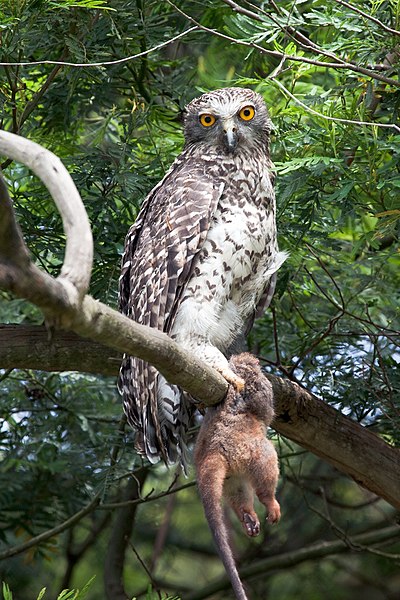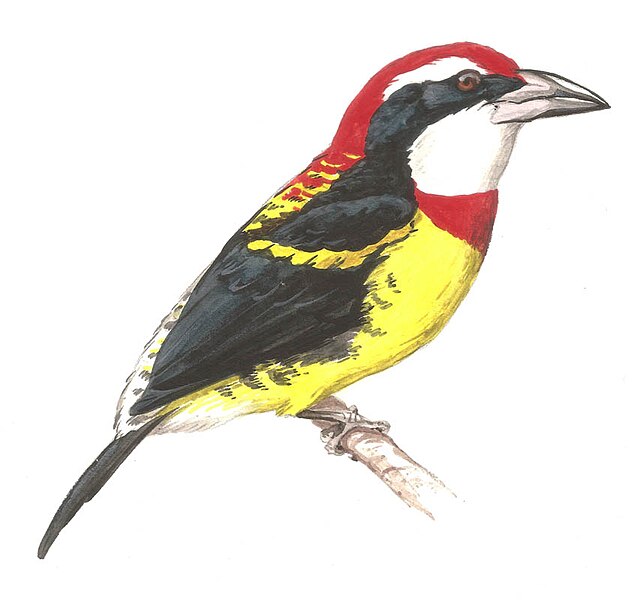 Hello, Frank Indiviglio here. Ranging from easily- overlooked little wrens to large owls and brilliantly- colored barbets, a variety of spectacular new bird species were discovered or described in the past year. Fossils of dinosaurs that may have displayed colorful feathers in a manner similar to modern-day peafowl and turkeys also grabbed our attention as 2012 drew to a close. Unfortunately, some depressing findings concerning accelerating avian extinctions also came to light. Today I’ll highlight a few species and news items that were of particular interest to me. I hope you enjoy, and please post your own favorites (whether covered here or not) below.
Hello, Frank Indiviglio here. Ranging from easily- overlooked little wrens to large owls and brilliantly- colored barbets, a variety of spectacular new bird species were discovered or described in the past year. Fossils of dinosaurs that may have displayed colorful feathers in a manner similar to modern-day peafowl and turkeys also grabbed our attention as 2012 drew to a close. Unfortunately, some depressing findings concerning accelerating avian extinctions also came to light. Today I’ll highlight a few species and news items that were of particular interest to me. I hope you enjoy, and please post your own favorites (whether covered here or not) below.
Sira Barbet, Capito Fitzpatricki
Montane cloud forests are well-known for sheltering creatures new to science, but even so ornithologists were surprised that the large, colorful, Sira Barbet was able to remain hidden from view for so long. Beautifully clad in scarlet, black and white, this bird was first glimpsed in 2008, but was misidentified as the related Scarlet Barbet (please see drawing).
The Sira Barbet seems limited to the Cerros del Sira mountain range in the Peruvian Andes, but surveys are incomplete, and we know little of its habits. I’ve always been very interested in barbets, and have had the good fortune of working with several species in zoos and private collections. Please see this article for more information, and be sure to post your own thoughts and observations.
Philippine Hawk Owls (Ninox spp.)
The Hawk Owls are an amazing group of birds that derive their common name from their streamlined body shape and the propensity of some to hunt by day (please see photo of the Australian Powerful Owl). Two new species, the Cebu Hawk Owl, Ninox runseyi, and the Camiguin Hawk Owl, N. leventesi, were described from the Philippines in 2012. Additionally, 5 subspecies of the Philippine Hawk Owl, N. philippinensis, were raised to full species status.
Based on recordings of owl calls and fleeting observations, ornithologists have long suspected that the Philippines supported a rich diversity of Hawk Owl species. Difficulties in surveying the region intervened – the Cebu Hawk Owl, for example, was observed only once before disappearing from view for 110 years. Today it is limited to 11 wooded patches and threatened by deforestation. We now know that each island supports distinct Hawk Owl species that vary in plumage, size, vocal abilities and habits. Future studies may reveal how these owls, and other birds, colonized the region’s numerous islands.
Cebu Hawk Owl pairs engage in “duets”; please click here for a recording.
Antioquia Wren, Thryophilus sernail
With nearly 1,900 species recorded, Columbia is home to more avian diversity (as far as we know) than anywhere else on earth. One of the newest additions to its impressive species list, the Antioquia Wren, was discovered a mere 45 minutes outside of the bustling city of Medellin. Apparently restricted to the northeastern Cauca River Canyon, its future is threatened by the construction of a hydro-electric power plant.
Feathered Oviraptor Dinosaurs
Related to the Tyrannosaurus rex, Oviraptors are 2-legged dinosaurs that roamed Canada, China and Manchuria during the Cretaceous Period. The link between modern-day birds and dinosaurs was recently strengthened by the discovery that certain Oviraptors may have engaged in mating displays similar to those now utilized by Peafowl and their relatives.
 Writing in the journal Acta Paleontologica Polonica, researchers theorize that anatomical features such as uniquely-structured vertebrae lent great flexibility to the tails of Similicaudiptery and other Oviraptors. This, and the presence of banded (perhaps colorful) feathers, arm fans and head-crests, may indicate that these dinosaurs engaged in complicated mating displays; please see article linked below for an artist’s conception.
Writing in the journal Acta Paleontologica Polonica, researchers theorize that anatomical features such as uniquely-structured vertebrae lent great flexibility to the tails of Similicaudiptery and other Oviraptors. This, and the presence of banded (perhaps colorful) feathers, arm fans and head-crests, may indicate that these dinosaurs engaged in complicated mating displays; please see article linked below for an artist’s conception.
The Bald Parrot and other Amazonian Wonders
In 2002, biologists were shocked by news that a large, bare-headed, noisy, blue and aquamarine parrot had been discovered in Brazil. Now known as the Bald or Orange-Headed Parrot, Pyrilia cephala, this spectacular creature is one of over 1,200 new species (excluding insects), 16 of which have been birds, uncovered in the Amazon Basin since 1999. Please see this article to learn more about the Bald Parrot.
Accelerated Avian Extinctions
And now for the bad news: A study by ornithologists from Birdlife International and Charles Darwin University has established that 279 bird species have become extinct over the past 500 years, with the rate of extinctions increasing in recent decades. Agricultural and mining expansion has replaced hunting and introduced species as the main cause of extinctions.
Conservation efforts have turned the tide in some cases, but not to the degree that had been hoped…recovery goals set by the International Convention on Biological Diversity have, of necessity, been moved from 2010 to 2020.
Please check out my posts on Twitter and Facebook. Each day, I highlight breaking research, conservation news and interesting stories concerning just about every type of animal imaginable. I look forward to hearing about your interests and experiences as well, and will use them in articles when possible.
Please also post your questions and comments below…I’ll be sure to respond quickly.
Thanks, until next time,
Frank Indiviglio
Further Reading
Discovery of the Antioquia Wren
Powerful Owl image referenced from wikipedia and originally posted by Moonlight0551
Scarlet banded Barbet image referenced from wikipedia and originally posted by GossipGuy
 That Bird Blog – Bird Care and History for Pet Birds
That Bird Blog – Bird Care and History for Pet Birds



